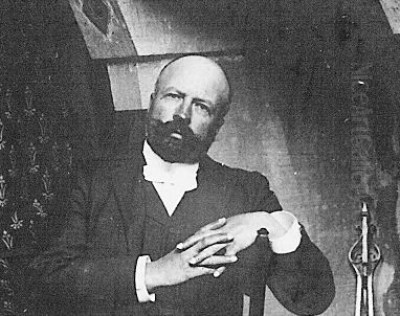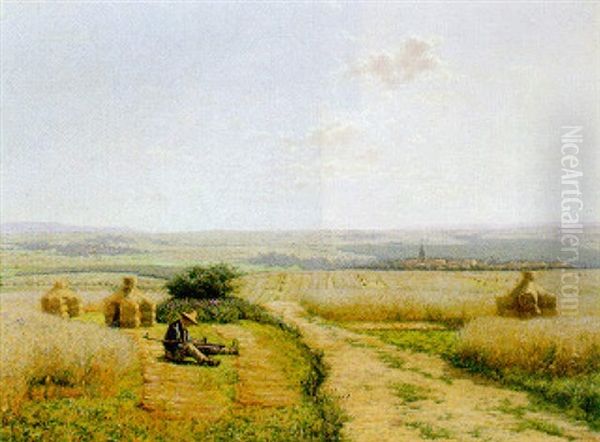
Jean Ferdinand Monchablon stands as a significant figure in late 19th-century French art, primarily celebrated for his evocative landscape paintings. Born in 1855 and passing away in 1904, Monchablon dedicated much of his artistic career to capturing the specific beauties of his native region in northeastern France. His work is characterized by a unique blend of detailed realism, reminiscent of photography, and a sensitive handling of light often associated with Impressionism, though he maintained a distinct style focused on structure and topographical accuracy. A respected artist within the established Salon system, Monchablon received numerous accolades during his lifetime and left behind a legacy of works that continue to be admired for their technical skill and tranquil beauty.
Early Life and Formative Years
Jean Ferdinand Monchablon entered the world in 1855 in the small village of Châtillon-sur-Saône, located in the Vosges department of northeastern France. This area, steeped in history with evidence of settlement dating back to the Neolithic period, would become the central inspiration for his artistic output. The rolling hills, serene rivers, and lush forests of the Vosges landscape profoundly shaped his visual sensibilities from a young age.
Interestingly, Monchablon's initial career path was not in art but in education. By the remarkably young age of nineteen, he was employed as a teacher at a college in Quimper, Brittany. It was during this period that he met Fanny Elisa Julien, a talented pianist who would later become his wife. This early experience in a different field highlights a thoughtful and perhaps multifaceted personality, before his ultimate dedication to the visual arts took hold.
Academic Training in Paris
Despite his early foray into teaching, the pull towards painting proved irresistible. Monchablon made the pivotal decision to move to Paris, the undisputed center of the art world at the time, to pursue formal artistic training. He enrolled at the prestigious École des Beaux-Arts, the leading institution for academic art education in France.

At the École, Monchablon had the distinct advantage of studying under two highly influential figures of the era: Jean-Paul Laurens and Alexandre Cabanel. Laurens was renowned for his large-scale historical paintings, executed with a strong sense of realism and dramatic flair. Cabanel, on the other hand, was a master of the academic style, celebrated for his smooth finish, idealized subjects, and mythological or historical themes, such as his famous The Birth of Venus. Studying under these prominent artists provided Monchablon with a rigorous foundation in drawing, composition, and traditional painting techniques between approximately 1881 and 1884. This academic grounding would remain evident in the structural integrity and detailed rendering found throughout his later work, even as he incorporated more modern influences. The environment at the École would have also exposed him to the prevailing artistic debates and the works of other established academicians like William-Adolphe Bouguereau and Jean-Léon Gérôme.
Development of a Distinctive Style
Monchablon's artistic style evolved into a compelling synthesis of different influences. While his academic training provided a strong base, he was clearly receptive to the artistic currents swirling around him, particularly the legacy of the Barbizon School and the innovations of Impressionism. His paintings often exhibit a meticulous, almost photographic realism in their depiction of details – the texture of bark, the structure of terrain, the specific architecture of a village.
However, this realism is consistently tempered by a keen sensitivity to light and atmosphere, qualities strongly associated with Impressionism. Unlike the often more fleeting moments captured by painters like Claude Monet or Camille Pissarro, Monchablon's light serves to illuminate the enduring structure and character of the landscape rather than dissolve it. His brushwork is typically described as clear and bright, contributing to a sense of clarity and precision. This fusion resulted in a style that felt both direct and meditative, offering a faithful yet personally interpreted vision of the natural world. He absorbed the Barbizon painters' (Jean-Baptiste-Camille Corot, Théodore Rousseau) dedication to landscape but rendered it with a finer detail and brighter palette, influenced perhaps by the Impressionists' study of light, yet without fully adopting their broken brushwork or focus on transient effects like Alfred Sisley.
The Landscapes of the Vosges
The heart of Monchablon's oeuvre lies in his profound connection to his homeland, the Vosges region, and particularly the valley of the Saône River near his native Châtillon-sur-Saône. He returned to this area repeatedly throughout his career, finding endless inspiration in its specific natural features. His canvases meticulously document the tranquil rivers winding through the countryside, the expansive, open pastures dotted with grazing cattle, the cool, shaded depths of the local forests, and the gentle contours of the rolling hills.
Monchablon possessed an exceptional ability to capture the unique topography and underlying structure of each location he painted. His commitment to accuracy was such that many of the specific sites depicted in his works remain identifiable even today. This fidelity suggests not just careful observation but a deep, abiding affection for the land. He wasn't merely painting generic rural scenes; he was chronicling the particular character and spirit of the Vosges, presenting its landscapes with both precision and a palpable sense of place.
Signature Landscape Works
Among Monchablon's most representative works are paintings that exemplify his dedication to the Vosges landscape. Titles like Scène fluviale (often translated as River Scene or River View) point directly to his fascination with the Saône and other local waterways. These works likely capture the calm surfaces of the river, reflections of trees and sky, and the gentle banks characteristic of the region, rendered with his typical clarity and attention to light.
Another key work mentioned is Village et vaches (Village with Cows, sometimes cited as Village with Cows and Rivers). This title suggests a composition integrating the built environment of a local village with the surrounding pastoral landscape, including the ubiquitous presence of cattle, vital to the region's agricultural life. Such paintings showcase his ability to harmonize natural scenery with elements of rural human settlement. Forest at Châtillon is another title indicating his focus on specific, beloved locations within his home territory, likely exploring the interplay of light and shadow beneath the trees. These works, praised during his lifetime, cemented his reputation as a premier painter of the French countryside.
Portraiture and Other Commissions
While primarily known for his landscapes, Jean Ferdinand Monchablon also undertook portrait commissions, demonstrating his versatility as an artist. His most acclaimed work in this genre is the portrait of Monseigneur Turinaz, exhibited with great success at the Paris Salon of 1896. This painting depicted the Bishop of Nancy delivering a speech commemorating the Battle of Gravelotte (a significant Franco-Prussian War battle), surrounded by figures representing the lost beauty of Alsace and Lorraine. The portrait was lauded for its emotional depth and historical resonance, showcasing Monchablon's ability to handle complex compositions and convey patriotic sentiment.
He also painted other notable figures, including a portrait of the French senator Louis Buffet in 1886. Furthermore, records indicate he received a commission to paint portraits for the Dominican convent in Etrepagny. An interesting, though less detailed, mention exists of a collaborative project with a painter identified only as "Jan". Together, they reportedly created a work titled L'Éducation de Léonore, intended as a gift for Tsar Alexander III of Russia to commemorate the Franco-Russian Alliance. These commissions highlight his standing within society and his engagement with historical and commemorative themes beyond pure landscape. His artistic milieu might also have included interactions with figures like the sculptor Émile-Eugène Hiolle, mentioned in related contexts.
Recognition and Exhibitions
Jean Ferdinand Monchablon achieved considerable recognition within the official art establishment of his time. Beginning in 1881, he became a regular exhibitor at the prestigious Paris Salon, the most important annual art exhibition in France. His participation is documented for numerous years, including 1885, 1895, 1896 (where his Monseigneur Turinaz was shown), 1897, 1898, and culminating in 1904, the year of his death, when he was awarded a third-class medal.
His reputation extended beyond the Salon to major international showcases. He received significant awards at the Expositions Universelles (World's Fairs) held in Paris, earning a silver medal in 1889 and another silver medal in 1900. These events were massive platforms for cultural exchange and artistic competition, and winning medals there signified considerable international standing. His work was also selected for exhibition further afield, including the Carnegie International Exhibition in Pittsburgh, Pennsylvania, demonstrating his reach into the American art scene. The culmination of his official recognition came posthumously when he was awarded the Chevalier de la Légion d'honneur (Knight of the Legion of Honour), France's highest order of merit.
Monchablon in Context
Placing Jean Ferdinand Monchablon within the broader context of late 19th-century French art reveals his unique position. He operated largely within the established Salon system, unlike the Impressionists who initially formed their own independent exhibitions to bypass the conservative Salon juries. While influenced by Impressionist handling of light, his commitment to detailed realism and solid structure aligned him more closely with the ongoing naturalist and realist traditions, albeit infused with a modern brightness. His teachers, Laurens and Cabanel, represented the powerful academic tradition.
His career unfolded during a period of immense artistic ferment. While Monchablon was refining his specific blend of realism and light, other artists were pushing boundaries in more radical directions. The Post-Impressionists, such as Paul Cézanne with his structural analysis, Vincent van Gogh with his expressive color and brushwork, and Paul Gauguin with his synthetist and symbolic approach, were charting entirely new territories. Symbolism was also gaining traction. Monchablon, however, remained dedicated to the observable world, finding sufficient depth and beauty in the faithful representation of his chosen landscapes. He likely exhibited alongside contemporaries at the Salon who shared a similar naturalist inclination, such as Pascal Dagnan-Bouveret, known for his meticulously rendered scenes of peasant life and religious subjects.
Legacy and Collections
Jean Ferdinand Monchablon passed away in 1904, leaving behind a substantial body of work primarily focused on the landscapes of the Vosges. His legacy is that of a dedicated and highly skilled chronicler of his native region, an artist who found profound meaning in the specific contours, light, and atmosphere of the Saône valley. He successfully navigated the official art world of his time, gaining recognition and awards through the Salon and international exhibitions.
His paintings are valued for their technical proficiency, their serene and meditative quality, and their faithful depiction of a specific part of rural France at the turn of the 20th century. Today, his works are held in various public collections, attesting to his enduring importance. Notable examples can be found in institutions such as the Amsterdam Museum in the Netherlands and the Milwaukee Art Museum in the United States, as well as in numerous French regional museums, particularly those in the Grand Est region (which includes the Vosges). His art continues to offer a window onto the tranquil beauty of the French countryside, rendered with clarity and deep affection.
Conclusion
Jean Ferdinand Monchablon carved a distinct niche for himself in the rich tapestry of late 19th-century French painting. As a master of landscape, he devoted his considerable technical skill, honed through academic training under masters like Laurens and Cabanel, to capturing the essence of his beloved Vosges homeland. His unique style, blending meticulous realism with a sensitivity to Impressionistic light, allowed him to create works that are both topographically accurate and atmospherically evocative. While not aligned with the avant-garde movements of his time, Monchablon achieved significant success within the established art world, earning medals and exhibiting widely. His legacy endures through his tranquil and luminous depictions of rural France, preserving the character of a specific region with enduring artistry and heartfelt sincerity.